博文
[转载]第四纪研究2017:新疆天山降水稳定同位素的时空特征与影响因素
||
王圣杰*, 张明军. 新疆天山降水稳定同位素的时空特征与影响因素. 第四纪研究, 2017, 37(5): 1119–1130. DOI: 10.11928/j.issn.1001-7410.2017.05.19
新疆天山降水稳定同位素的时空特征与影响因素
摘要:降水是水文循环的重要环节,研究降水中氢氧稳定同位素有助于深入理解水循环过程与陆-气相互作用。天山是亚洲中部干旱区典型的湿岛,也是新疆乃至亚洲中部水体同位素研究的关键区域。为了明确新疆天山降水稳定同位素的时空特征与影响因素,本文根据近年来建立的降水同位素监测网络,介绍了该区域降水同位素的基本情况以及水汽再循环、云下蒸发、水汽路径和天气系统等因素对降水同位素的影响。总体而言,降水中的δD和δ18 O呈南高北低和夏高冬低的趋势,但是过量氘(d)却没有如此明显的时空特点,区域大气水线的斜率和截距均低于全球大气水线;各采样点降水同位素比率与气温存在显著的正相关关系,但各地降雪(或降雨)样品与所有样品之间的同位素温度梯度相对大小并没有一致的规律;利用降水同位素温度效应以及气温和降水量格网化数据,再结合实测资料订正即可得到降水同位素景观图。同位素三元混合模型可用于评估绿洲区水汽再循环,绿洲区植物蒸腾水汽对降水的贡献率普遍大于地表蒸发水汽的贡献率;基于改进的Stewart模型,云下二次蒸发对南坡降水同位素的影响较北坡大,对夏半年的影响较冬半年大,云下蒸发效应订正后降水同位素的区域一致性更加明显;与其他天气系统相比,中亚低涡控制下的降水中重同位素更为贫化,结合大气比湿订正的拉格朗日模型发现,天山南坡和北坡降水同位素差异亦与不同的水汽传输路径有关。
主题词:新疆 天山 降水 稳定同位素
中图分类号 P339;P426.6 文献标识码 A
2017-05-12 收稿,2017-07-16 收修改稿
1 引言
亚洲中部干旱区是北半球温带与暖温带面积最大的干旱区,以天山山脉为代表的高大山体对西风气流带来的水汽起到抬升与拦截作用,这使得高海拔地区形成相对充沛的降水,成为亚洲中部的湿岛[1, 2]。天山山脉东西绵延2500km以上,就中国新疆境内的部分而言,天山汇集了新疆40.4 %的年降水量[3],占据了新疆32.8 %的冰川储量[4]以及53.6 %的径流量[1]。在当前全球变暖的背景下,天山地区降水与径流的变化对该区域生态环境产生了广泛而深刻的影响[5~7]。
降水是水文循环的重要环节,也是陆地水资源的根本来源,研究降水中氢氧稳定同位素有助于深入理解水循环过程与陆-气相互作用,并为同位素技术应用于各学科领域提供基础[8~10]。在过去的几十年中,天山成为新疆乃至整个亚洲中部干旱区水体同位素研究的热点区域,尤其是对天山北坡乌鲁木齐河中上游的降水氢氧同位素开展了一系列的监测研究[11~18],全球降水同位素网络[19, 20]和中国大气降水同位素观测网络[20~22]在乌鲁木齐河中游及其附近区域也有多年的监测记录。然而,长期以来天山绝大部分区域的降水同位素却少有全年的监测。
集中于乌鲁木齐河中上游开展工作固然有助于认识该区域的水循环机理[23, 24],但是作为天山北坡的一个小流域可能尚不足以概括整个天山地区的同位素特征。天山地区气候水文条件差异较大,从南坡到北坡、从西段到东段其水循环特点并不一致[1]。那么,天山地区降水同位素的空间格局到底如何?乌鲁木齐河中上游的研究结果是否适用于更为干旱的南坡地区?水汽再循环、云下蒸发、水汽来源等诸多因素究竟如何控制新疆天山不同区域的降水同位素?
为了明确这些问题,近年来西北师范大学地理与环境科学学院在新疆天山山区和南北坡的20余个采样点开展了降水氢氧稳定同位素监测研究,首次在新疆天山建立如此大规模的同步监测体系,这为探究亚洲中部干旱区的降水同位素提供了良好的平台。基于这些监测数据,我们对该地区一些不甚明确的问题进行了研究,例如降水同位素景观图的建立[25]、基于同位素手段的绿洲蒸腾水汽对降水的贡献率评估[26]、降水同位素的云下蒸发效应评估[27]以及水汽路径和天气系统对降水同位素的影响[28]等。本文是对近年来该监测网络的一个总结,对目前新疆天山降水同位素研究中的几个关键问题做出梳理,从而深入认识亚洲中部干旱区降水稳定同位素的时空特征与影响因素。
2 研究区与工作概况
天山是亚洲中部最大的纬向山系,横亘于中国、哈萨克斯坦、吉尔吉斯斯坦和乌兹别克斯坦等国,东西长2500km以上(图 1a)。其中,中国境内的部分(又称中国天山或东天山),位于新疆维吾尔自治区中部,西起吉尔吉斯斯坦和中国的国界,东至哈密以东的星星峡戈壁,东西连绵约1700km,南有塔里木盆地,北有准噶尔盆地。天山地区的年降水量空间分布极不均匀(图 1b),总体而言,西段降水量多于东段,北坡降水量多于南坡,迎风坡降水量多于背风坡,高海拔地区降水量多于低海拔地区[1]。新疆天山山区的年均降水量为409.1mm,约为北疆的1.5倍,南疆的6.2倍[3]。降水普遍集中于夏半年(4月~10月),冬半年(11月~翌年3月)绝大多数区域的降水量很少,这种降水的集中程度在山区更为明显[1]。在过去的几十年中,天山山区降水量和水汽含量均呈增加趋势[29, 30],不同水汽源地对新疆降水的贡献也在发生变化[31]。1961~2010年,北疆、天山山区和南疆的降水量增幅为6.80 % /10a、4.61 % /10a和9.48 % /10a,年降水日数增幅为2.54 d/10a、1.72 d/10a和1.42 d/10a,2001~2010年的年均降水量比1961~1970年的分别增加了45.7mm、53.8mm和24.0mm,增幅为26 %、17 %和52 % [32]。
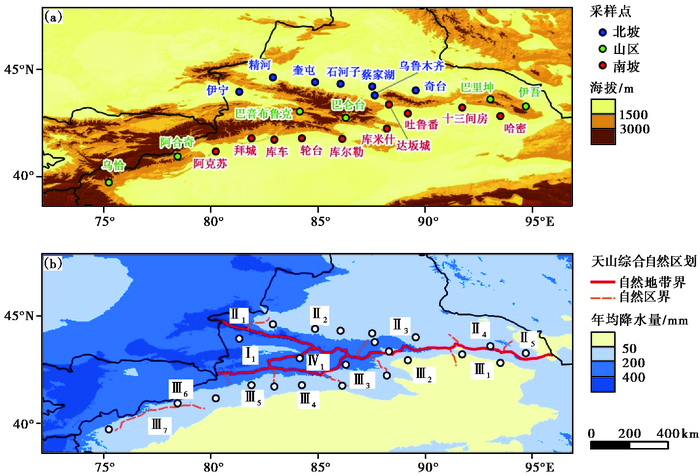 | 图 1 新疆天山地区海拔与多年平均降水量的空间分布Ⅰ —伊犁谷地温带荒漠草原自然地带:Ⅰ 1—伊犁谷地自然区;Ⅱ—天山北坡中温带荒漠自然地带:Ⅱ1—博尔塔拉谷地自然区、Ⅱ2—精河-昌吉南部山地自然区、Ⅱ3—乌鲁木齐-木垒南部山地自然区、Ⅱ4—巴里坤-三塘湖盆地自然区、Ⅱ5—伊吾-淖毛湖盆地自然区;Ⅲ—天山南坡暖温带荒漠自然地带:Ⅲ1—哈密盆地自然区、Ⅲ2—吐鲁番盆地自然区、Ⅲ3—焉耆盆地自然区、Ⅲ4—库尔勒-库车北部山地自然区、Ⅲ5—拜城盆地自然区、Ⅲ6—天山南脉-托什干谷地自然区、Ⅲ7—柯坪-哈尔峻盆地自然区;Ⅳ—巴音布鲁克寒温带草原-草甸自然地带:Ⅳ1—巴音布鲁克(尤尔都斯)盆地自然区[1]Fig. 1 Spatial distribution of altitude and annual mean precipitation amount across the Chinese Tianshan Mountains |
根据《中国天山自然地理》中提出的天山综合自然区划[1],天山地区可划分为4个自然地带14个自然区(图 1b),即:1) 伊犁谷地温带荒漠草原自然地带(Ⅰ),含伊犁谷地(Ⅰ 1)自然区,向西的谷口有利于西风水汽输入,有大量地表径流外流,植被覆盖度高;2) 天山北坡中温带荒漠自然地带(Ⅱ),含博尔塔拉谷地(Ⅱ1)、精河-昌吉南部山地(Ⅱ2)、乌鲁木齐-木垒南部山地(Ⅱ3)、巴里坤-三塘湖盆地(Ⅱ4)、伊吾-淖毛湖盆地(Ⅱ5)自然区,东、西段山势低,中段高大,有利于拦截西风气流,河网密度较高,地形切割较深;3) 天山南坡暖温带荒漠自然地带(Ⅲ),含哈密盆地(Ⅲ1)、吐鲁番盆地(Ⅲ2)、焉耆盆地(Ⅲ3)、库尔勒-库车北部山地(Ⅲ4)、拜城盆地(Ⅲ5)、天山南脉-托什干谷地(Ⅲ6)、柯坪-哈尔峻盆地(Ⅲ7)自然区,西部山势高峻,山地干燥少林木,山间盆地多于山间谷地;4) 巴音布鲁克寒温带草原-草甸自然地带(Ⅳ),含巴音布鲁克(尤尔都斯)盆地(Ⅳ1)自然区,属高位山间盆地,中心为大面积沼泽湿地。在《中国干旱区自然地理》[2]中,中国干旱区分为9个自然区,具体到了天山地区涉及其中的5个,即准噶尔盆地荒漠自然区(大致相当于天山综合自然区划的Ⅱ)、伊犁-巴音布鲁克中天山自然区(大致相当于Ⅰ和Ⅳ)、哈密(戈壁)荒漠自然区(大致相当于Ⅲ 1)、吐鲁番盆地荒漠自然区(大致相当于Ⅲ 2)和塔里木盆地极端干旱荒漠自然区(大致相当于Ⅲ 3~Ⅲ7)。
| 表 1 新疆天山地区各采样点地理位置、1981~2010年主要气候参数与2012~2013年降水中δD、δ18 O和d加权平均值[25]Table 1 Inventory of locations, long-term climatology during 1981~2010 and amount-weighted δD, δ 18 O and deuterium excess(d) in precipitation during 2012~2013 for each sampling site across the Chinese Tianshan Mountains[25] |
研究工作先后得到了国家自然科学基金委员会、西北师范大学、中国第四纪科学研究会、冰冻圈科学国家重点实验室、中国气象局乌鲁木齐沙漠气象研究所等机构的资助。样品采集工作主要依托新疆维吾尔自治区气象局各基层气象台站和中国科学院相关野外台站完成,部分采样由课题组工作人员实地完成,根据研究目的设计不同时空尺度的监测方案。其中,2012~2013年曾在23个气象台站(表 1)同步采集降水样品[25],对整个天山地区实现了较好的空间覆盖,囊括中国天山综合自然区划[1]中所有4个自然地带,并涵盖14个自然区中的12个,同样也包括了中国干旱区自然地理区划[2]涉及到的全部5个自然区。
3 降水同位素的时空特征
根据2012~2013年新疆天山地区的降水同位素监测结果[25],降水中的δD和δ 18 O加权平均值在空间分布上整体呈南高北低的趋势,过量氘(即d=δD-8δ 18 O)则没有表现出明显的空间规律(图 2);与北坡和山区相比,南坡降水δD和δ 18 O出现正值的几率更大,这显然与南坡更为干旱的气候背景有关。从季节变化(图 3)上看,降水中稳定同位素的冬夏差异非常明显,夏半年的δD和δ 18 O比冬半年的要高得多;相比之下,d则没有一致的季节规律,即使是单独查看各个采样点也往往没有类似δD和δ 18 O那样明显的冬夏差异。
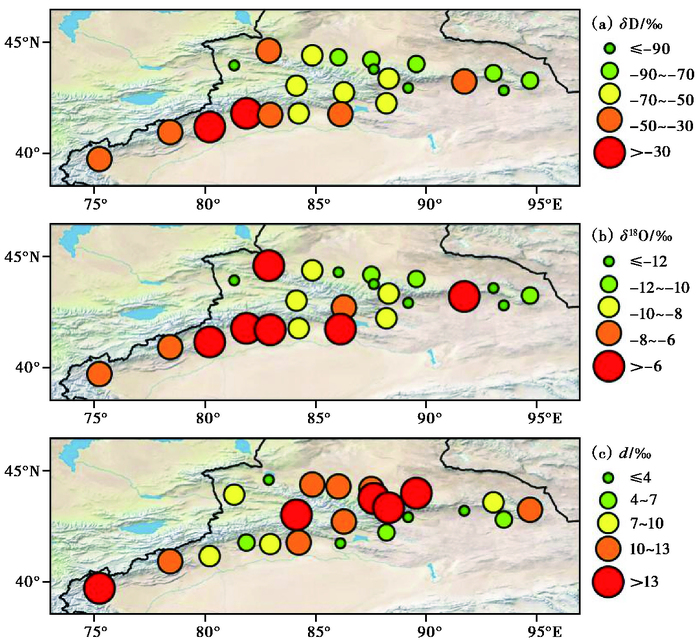 | 图 2 2012~2013年新疆天山地区各采样点降水中δD、δ 18 O和d加权平均值的空间分布(据文献[25]数据)Fig. 2 Spatial distribution of amount-weighted δD, δ 18 O and deuterium excess (d) in precipitation for each sampling site across the Chinese Tianshan Mountains during 2012~2013(based on the data in reference[25]) |
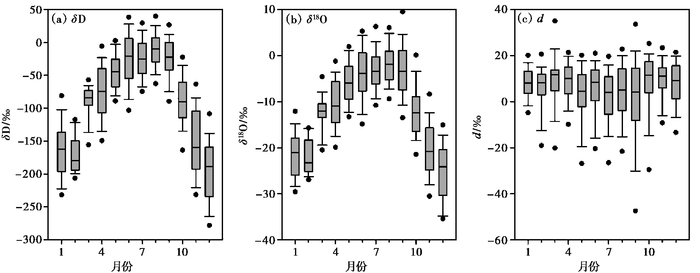 | 图 3 2012~2013年新疆天山地区降水中δD、δ 18 O和d的月变化(据文献[25]数据)Fig. 3 Monthly variation of δD, δ 18 O and deuterium excess (d) in precipitation across the Chinese Tianshan Mountains during 2012~2013(based on the data in reference[25]) |
基于2012~2013年采集的1052个事件尺度的降水样品[25],新疆天山地区的大气水线(Local Meteoric Water Line,简称LMWL)为δD=7.36δ 18 O-0.50(r2=0.97,n=1052);考虑到全球降水同位素网络(Global Network of Isotopes in Precipitation,简称GNIP)和中国大气降水同位素观测网络(Chinese Network of Isotopes in Precipitation,简称CHNIP)一般为月尺度数据,为便于比较,如果根据逐次事件的降水量将事件尺度数据加权为月尺度,则大气水线为δD=7.60δ 18 O+2.66(r2=0.98,n=230);如果按各采样点的加权平均值计算,则大气水线为δD=7.70δ 18 O+5.74(r2=0.96,n=23)(图 4)。与全球大气水线[33](Global Meteoric Water Line,简称GMWL;即δD=8δ 18 O+10) 相比,本研究区的大气水线斜率和截距都是相对较低的。与之前的全国尺度监测结果相比,新疆天山地区的大气水线斜率(7.60) 与西北干旱区的斜率(7.06~7.83)[20]基本吻合。
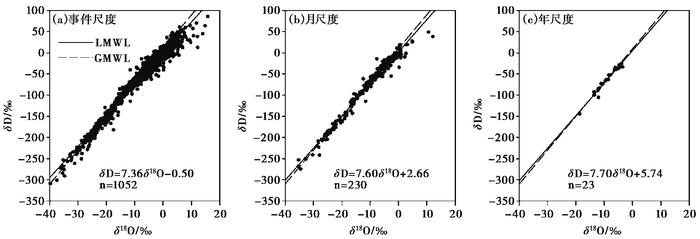 | 图 4 2012~2013年新疆天山地区事件尺度、月尺度和年尺度的大气水线(据文献[25]数据)Fig. 4 Local meteoric water line(LMWL)using event-based, monthly and annual data across the Chinese Tianshan Mountains during 2012~2013(based on the data in reference[25]) |
在以往的研究[8, 15, 20]中,天山地区降水同位素常被认为具有温度效应。本监测网络也证实了这样的结论[25],在事件尺度下各采样点降水同位素与气温都存在正相关关系,且均通过了0.05水平的显著性检验;与此同时,各采样点的降水量与δ 18O普遍没有显著相关性。在区域尺度上,降水同位素的温度效应可以表述为δ 18O=0.78T-16.01(r2=0.73,n=1052),各采样点δ 18O与气温的回归系数在0.54 ‰ /℃(阿克苏)~1.14 ‰ /℃(哈密)间波动[25]。此前在天山山区乌鲁木齐河上游开展的研究[16]发现降雪与降雨事件的δ 18O-T梯度存在差异。如果将整个研究区纳入考虑[25],雪样和雨样(雨夹雪等不考虑)的温度效应可以分别表示为δ 18O=0.68T-17.38(r2=0.28,n=208) 和δ18O=0.67T-14.05(r2=0.36,n=813),不难发现仅从δ 18 O-T斜率上看并没有较大的差异。重点考察降雪样本稍多的7个采样点(降雪事件10次以上)亦可发现,在蔡家湖、乌鲁木齐和巴音布鲁克,雪样的δ18O-T斜率大于所有降水的δ18O-T斜率,而在伊宁、石河子、奇台和巴里坤则相反[25]。由此可见,降雪(或降雨)事件与所有事件的δ18O-T梯度相对大小并不存在一致的规律,这在古气候研究中值得注意,但是关于差异的深层原因仍需做进一步的研究。
近年来,同位素的空间分布,即同位素景观图(isoscape,又译同位素景观图谱等),在国际上得到了较高的关注[34]。除同位素大气环流模式[35~37]外,目前常见的地理信息系统实现思路[8]是基于已知采样点降水同位素信息拟合其与其他参数(如纬度和海拔[38],或者纬度和温度[39])之间的关系,利用纬度、海拔、温度等参数作为输入项得到预测值,再结合残差订正得到。具体到了新疆天山地区,直接利用以往全国范围得到的经验参数并不能较好地模拟出降水同位素空间分布,降水同位素温度效应的存在为我们提供了建立该区域同位素景观图的新思路。也就是说,可以利用实测的温度与同位素比率的线性关系入手,以高时空分辨率的气温和降水量格网化产品(例如国家气象信息中心发布的0.5°×0.5°逐日地面气温和降水量数据)作为输入项,降水量用于加权,再结合实测资料订正即可得到较高质量的降水同位素景观图[25]。从预测δ18O值的平均偏差、平均绝对误差和均方根误差等指标[25]来看,该方法可以较好地用于亚洲中部干旱区降水同位素景观图的建立,其误差优于以往基于纬度和海拔的几种方法。在这种景观图的计算思路中降水同位素随气温和降水量变化,因而有助于理解降水同位素在不同时间尺度(从多年尺度到日尺度)上的变化过程,可以为实地监测匮乏的区域提供借鉴。
4 降水同位素的影响因素分析4.1 水汽再循环对降水同位素的影响
由地表土壤和水体蒸发产生的水汽以及植物蒸腾产生的水汽,又称再循环水汽。在亚洲中部干旱区,绝大部分区域被沙漠戈壁覆盖,再循环水汽的绝对量比较有限,但对降水匮乏的区域而言可能足以对局地降水的形成产生不可忽视的贡献[40]。特别是在广泛分布的现代绿洲上,人工渠道和水库等开放水体、灌区农田土壤以及城区景观水体等贡献了大量的蒸发水汽,而城郊的农田以及城区的绿化等也提供了可观的蒸腾水汽[41, 42]。地表蒸发和植物蒸腾过程伴随着同位素的分馏,因此可以利用同位素混合模型估算再循环水汽对降水的贡献率(即水汽再循环比)[8]。在乌鲁木齐河中上游[23]曾有同位素二元混合模型的应用案例,但是二元模型将降水水汽分为外来水汽和地表蒸发水汽两部分,并没有考虑植物蒸腾水汽的贡献,一定程度上低估了绿洲区的水汽再循环比;另外限于采样条件,对于水汽来源的上风向往往缺乏同步采样,结合冬季降水同位素计算全年上风向水汽同位素可能也引入了较大的不确定性。考虑到植物蒸腾对绿洲降水的重要贡献,有必要强化三元混合模型的应用,将降水水汽按照外来水汽、地表蒸发水汽和植物蒸腾水汽三部分进行计算[8, 42]。
不妨选取天山北坡典型的西风路径作为重点,以实测的降水同位素作为主要输入项,结合气象记录以及对地表水、植物水、土壤水等水体中同位素的认识,分别估算外来水汽、地表蒸发水汽、植物蒸腾水汽以及降水水汽中的同位素比率,再基于同位素三元混合模型评估绿洲区再循环水汽对降水的贡献率[26]。以伊宁—石河子—蔡家湖/乌鲁木齐一线[26]为例(图 5),结果显示在乌鲁木齐,再循环水汽对降水的贡献率达到16.2 %,其中蒸发和蒸腾的贡献率分别为5.9 % ±1.5 %和10.3 % ±2.2 %,而在石河子和蔡家湖再循环水汽的贡献率小于5 %;需要注意,在这3个目标研究地,蒸腾水汽对降水的贡献率均大于蒸发水汽的贡献率,可见将蒸腾水汽纳入新疆水汽再循环研究是必要的。
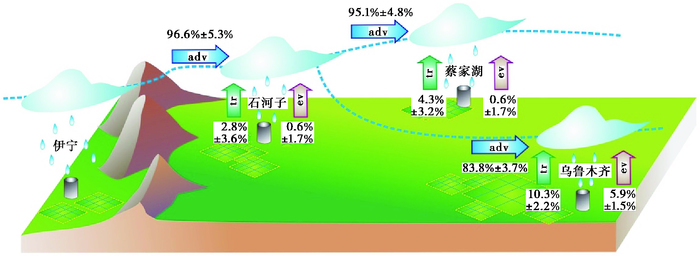 | 图 5 基于同位素三元混合模型的伊宁—石河子—蔡家湖/乌鲁木齐一线水汽传输与再循环模式图(据文献[26]修改)adv—外来水汽,tr—蒸腾水汽,ev—地表蒸发水汽Fig. 5 Schema chart of moisture transport and recycling over the line of Yining-Shihezi-Caijiahu/Vrümqi based on a three-component isotopic mixing model, modified from reference[26] |
在同位素混合模型研究中,模型的算法改进与不确定性评估在近年来越来越受到重视,我们的研究中也在这方面做了很多的尝试[26]。例如,植物蒸腾水汽同位素是三元混合模型的必需项,限于水汽同位素实时监测尚不能大规模推广,同位素混合模型多是直接用降水同位素代替[43],即认为植物能够吸收利用的水其根本来源是降水;一些研究利用实测植物木质部水同位素代替蒸腾水汽同位素[42],这其实包含了同位素稳态假设,在一日之中满足稳态假设的时段很短,况且实地采样可能还要面临选择采样点、采样时段、采样物种等一系列包含着不确定性的问题。我们对比了新疆几种典型植物的木质部水同位素[44~46]和降水同位素的变化范围,发现植物木质部水同位素随季节和物种呈现出较大的波动,但植物木质部水与降水的同位素波动范围总体表现出较好的一致性,这意味着利用降水同位素平均值代替的思路在一定程度上是可取的[26]。而在三元混合模型的敏感性分析[26]中,我们发现如果植物水同位素(或者说蒸腾水汽同位素)在某些范围内波动时,外来水汽、蒸发水汽和蒸腾水汽的贡献率变化可能并不明显,其敏感程度随采样点和植物水同位素变化而变化;总体而言,蒸腾水汽中重同位素越贫化,蒸腾水汽贡献率越大,外来水汽贡献率越小,并且二者贡献率的误差范围都明显更大。这些认识对于未来同位素方法的应用提供了有益的思路。
此外,在基于降水同位素比率估算水汽同位素比率[26]时,我们采用了一种不含平衡分馏假设的订正方法[47],摒弃了以往常见的平衡分馏假设,其改进效果也得到了青藏高原[48]等不同地区实测数据的支持。对于外来水汽、蒸发水汽和蒸腾水汽的贡献率,我们也给出标准误差以及95 %置信区间[49]。当然,同位素混合模型参数复杂,一些常用的概念化算法也未必完全符合实际情况,如何更为科学地评估同位素混合模型的不确定性,还需要更多的实验与理论支持。
4.2 云下蒸发对降水同位素的影响
雨滴从云底降落到地面,在空气不饱和的条件下会发生蒸发现象,即云下二次蒸发。在干旱条件下,云下蒸发不仅会使雨滴体积变小甚至完全蒸发殆尽,而且会影响降水中的同位素比率[8, 50, 51]。对比不同降水量、气温、相对湿度、降水相态条件下δD、δ18O和d以及大气水线斜率和截距的差异,可以反映出云下蒸发对降水同位素的影响程度[52, 53],在新疆天山地区也可以得到类似的认识。
然而,云下二次蒸发究竟使新疆天山地区降水同位素变化了多少,这是同位素研究中值得关注的一个问题[54]。近年来,各种基于Stewart模型[55]的改进算法被用于评估云下蒸发效应[51, 56, 57],此类模型根据气象参数模拟从云底到地面之间水滴的蒸发率以及同位素的变化过程。在以往文献的基础上我们给出了物理意义更为清晰的计算流程,并对降水高度的算法、雨滴直径的算法、单位时间内的雨滴蒸发质量的插值方法等方面也做了相应的优化[27]。研究结果[27]表明,从云底降落到地面,各采样点降水中同位素发生了不同程度的变化,南坡受云下蒸发的影响比北坡的要大,夏半年的影响要比冬半年的大。值得一提的是,根据同位素云下蒸发效应订正后的一些采样点呈现出更为明显的区域一致性[27],这说明部分区域受云下蒸发的影响较大,使得同位素的区域性特征被掩盖了,因此在干旱区利用降水同位素示踪水文过程的时候应该充分考虑到二次蒸发的影响。
随着Stewart模型的推广,关于云下过程中的雨滴蒸发率(或雨滴蒸发剩余比)与同位素比率之间的关系也受到关注[27, 51]。例如,在阿尔卑斯山区的研究[51]发现雨滴蒸发率较低时每增加1 %,d降低约1 ‰。限于此类模型输入参数多,不少研究直接利用不同采样点的降水同位素差异和1 ‰ / %线性关系反推雨滴蒸发率[53, 58]。实际上,新疆天山地区的研究[27]表明,上述1 ‰ / %线性关系未必适用于所有降水事件,在低气温、高相对湿度、高降水强度、大雨滴直径的条件下,雨滴蒸发剩余比与d变化量存在较好的线性关系,且斜率相对较小;而在相对干燥的条件下,二者的线性关系变弱,斜率也较大(图 6)。
 | 图 6 2012~2013年新疆天山地区降雨事件时气温、相对湿度和雨滴直径变化(箱形图)及不同条件下雨滴蒸发剩余比与d变化量的回归系数和决定系数变化(折线图)(据文献[27]数据计算)Fig. 6 Box plots showing air temperature, relative humidity and drop diameter in rain events and line charts showing regression and determination coefficients between mass remaining ratio and deuterium excess(d) variation for different conditions across the Chinese Tianshan Mountains during 2012~2013(calculated using the data in reference[27]) |
我们还注意到,同位素变化量对气象参数的敏感性也存在区域差异。例如,对各采样点的气温全部升高或降低某一数值,天山南坡比北坡更加敏感;相对湿度也有类似的特点,同样升幅或降幅条件下,南坡的降水同位素变化亦比北坡敏感[27];此外,雨滴的直径是模拟所需的重要参数,由于雨滴谱的实测数据极少,不少云下二次蒸发模拟研究中都将其设为常数[23, 51],但是实际上将雨滴直径设为统一值未必符合干旱区的降水特点。以0.2mm为步长计算雨滴直径在0.3~4.4mm之间时的雨滴d变化量[27],结果表明雨滴直径的影响十分明显,特别是当雨滴直径较小的情况下,降水中d变化量普遍较大。
4.3 水汽路径与天气系统对降水同位素的影响
除了上述影响新疆天山地区降水同位素的因素外,氢氧稳定同位素可能同样蕴含了水汽来源与输送过程的信息[59, 60]。这一区域降水中重同位素夏季富集、冬季贫化的季节特点被广泛认为反映了西风水汽的主导性,与青藏高原北部降水同位素比率的季节变化比较接近[61]。这一认识也得到了全球再分析资料的支持,天山地区全年受到西风水汽的作用,但是夏半年水汽输送强烈,冬半年水汽含量少;就大气层下部而言,北坡西风水汽通道明显更为通畅,而南坡受地形影响水汽输送较弱[26, 28]。天山南坡和北坡水汽输送特点的差异也对应着北坡降水中重同位素普遍较南坡更为贫化[25, 28]。
降水中重同位素的贫化或富集与天气系统有着密切的联系,结合气象学视角探究天气系统与降水同位素之间的关系也有助于理解降水同位素时空差异的内在机理[62, 63]。对影响新疆大降水事件的主要天气系统(中亚低涡、中亚短波槽、北支锋区低槽和中亚长波槽等)进行判读,发现不同天气系统下的降水同位素比率以及气象条件(如降水量、降水时段平均气温和相对湿度等)存在差异(图 7),在中亚低涡这一天气系统控制下降水中重同位素普遍都更为贫化,这意味着中亚低涡与其他天气系统相比可能具有不同的温压结构[28]。选取典型的中亚低涡和中亚短波槽过程分析各采样点降水发生的时长和先后顺序以及降水同位素随时间的变化情况[28],也可以发现中亚低涡不同于其他天气系统的特点。
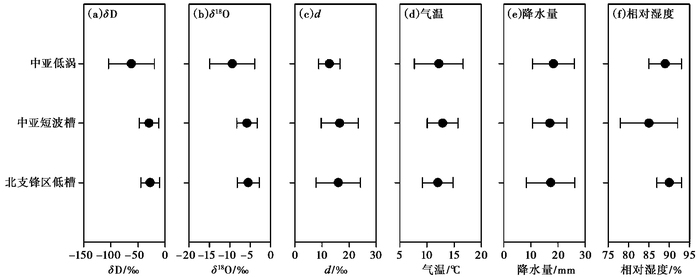 | 图 7 2013年夏季新疆天山地区不同天气系统下代表性降水δD、δ 18 O和d以及主要气象参数的平均值与标准差比较(据文献[28]数据)Fig. 7 Comparison of arithmetic average and standard deviation of δD, δ 18 O and deuterium excess(d) in typical precipitation as well as meteorological parameters for each synoptic system across the Chinese Tianshan Mountains in summer of 2013(based on the data in reference[28]) |
以HYSPLIT为代表的拉格朗日模型[64],常用于和降水或水汽同位素对比进而辨析水汽路径。为了分析水汽路径与降水同位素的联系,我们选用了一种经过大气比湿订正的拉格朗日模型[65, 66],将轨迹上的气象要素也纳入考虑,从轨迹上水汽的补给强度角度来判断水汽的源地,摒除了以往研究中固定回溯时间带来的影响[28]。简单说来,就是在后向回溯的过程中,较早时刻的比湿高于后一时刻的比湿超过某一阈值且气团轨迹模拟高度位于行星边界层以下的情况时,即判断为水汽的源地,对回溯得到的源地与后向轨迹路径上的气象参数和相应的降水同位素比率也一并进行统计整理[66]。经过比湿判断水汽补给情况后,气团回溯路径普遍变短;对比不同水汽路径的降水同位素,可以发现南坡和北坡的水汽来源存在明显差异,北坡重同位素贫化可能受偏北水汽路径影响更大[28]。
5 研究展望
近年来在新疆天山地区开展的降水氢氧稳定同位素同步监测工作,有助于明确天山地区降水同位素的时空格局与影响机制,尤其是在水汽再循环、云下蒸发、水汽路径和天气系统等方面获得了一些新的认识,这对理解亚洲中部干旱区水循环过程和陆-气相互作用机制有促进作用。结合现有监测体系和研究结果,未来有必要进一步关注以下几个方面:
(1) 事件尺度降水同位素的深入研究。相较于以逐月降水同位素为主的全球降水同位素网络,事件尺度降水稳定同位素监测的一个优势就是能够反映出水文过程中的更多细节信息。高时间分辨率的降水同位素数据蕴含了大量的环境信息,结合气象学视角,对这些同位素信息的识别有助于认识降水形成的机制。
(2) 降水同位素年际变化的监测研究。事件尺度的降水同位素多年连续监测在国内还不多,不同年度水汽输送路径和区域水分收支平衡往往存在着不同程度的差异,这会体现在降水同位素的年际差异上。当然,同位素的年际差异研究除了需要以实地降水采集为基础,也有必要借助同位素大气环流模式以及冰芯等气候代用指标。
(3) 实地监测与遥感技术、同位素大气环流模式的有机结合。随着遥感反演水汽稳定同位素产品和同位素大气环流模式的广泛应用,降水同位素与水汽同位素的联系也越发受到关注。将实地监测资料与这些手段有机结合起来,将有助于深入理解干旱区水文过程中氢氧同位素的分馏过程。
致谢: 感谢新疆维吾尔自治区气象局观测网络处和参与本项目的各级气象局(站)以及中国科学院天山冰川观测试验站在样品采集过程中的辛勤工作,感谢课题组成员多年来在野外调研、实验室分析和数据处理中的参与,感谢澳大利亚核科学技术组织(ANSTO)的Catherine Hughes博士和Jagoda Crawford博士、美国俄勒冈州立大学(Oregon State University)的Stephen Good博士、澳大利亚皇家墨尔本理工大学(RMIT University)的Matthew Currell博士、中国科学院西北生态环境资源研究院李忠勤研究员、任贾文研究员、康世昌研究员、李宗省副研究员、同济大学刘忠方教授、中国科学院地质与地球物理研究所孔彦龙副研究员等专家的建议;感谢审稿专家中肯的修改意见和杨美芳老师细致耐心的编辑,使论文得以完善!本文受到国家自然科学基金项目(批准号:41161012和41240001)、西北师范大学青年教师科研能力提升计划项目(批准号:NWNU-LKQN-15-8) 共同资助。
参考文献(References)
| 1 | 胡汝骥. 中国天山自然地理. 北京: 中国环境科学出版社, 2004. |
| 2 | 陈曦. 中国干旱区自然地理. 北京: 科学出版社, 2010. |
| 3 | 史玉光, 孙照渤, 杨青. 新疆区域面雨量分布特征及其变化规律. 应用气象学报, 2008, 19(3): 326-332. |
| 4 | 刘时银, 姚晓军, 郭万钦, 等. 基于第二次冰川编目的中国冰川现状. 地理学报, 2015, 70(1): 3-16. |
| 5 | Sorg A, Bolch T, Stoffel M, et al. Climate change impacts on glaciers and runoff in Tien Shan(Central Asia). Nature Climate Change, 2012, 2(10): 725-731. DOI:10.1038/nclimate1592 |
| 6 | Chen Y, Li W, Deng H, et al. Changes in Central Asia's water tower:Past, present and future. Scientific Reports, 2016, 6: 35458. DOI:10.1038/srep35458 |
| 7 | 庞忠和. 新疆水循环变化机理与水资源调蓄. 第四纪研究, 2014, 34(5): 907-917. |
| 8 | Zhang M, Wang S. A review of precipitation isotope studies in China:Basic pattern and hydrological process. Journal of Geographical Sciences, 2016, 26(7): 921-938. DOI:10.1007/s11442-016-1307-y |
| 9 | 赵华标, 徐柏青, 王宁练. 青藏高原冰芯稳定氧同位素记录的温度代用性研究. 第四纪研究, 2014, 34(6): 1215-1226. |
| 10 | 王芳, 孙青, 蔡炳贵, 等. 辽宁本溪庙洞降水、滴水和现生碳酸钙的δ18 O变化特征及其古气候意义. 第四纪研究, 2016, 36(6): 1370-1382. |
| 11 | 郑淑慧, 侯发高, 倪葆龄. 我国大气降水的氢氧稳定同位素研究. 科学通报, 1983, 28(13): 801-806. |
| 12 | 渡边兴亚, 武筱舲, 池上宏一, 等. 天山东部冰川的氧同位素特征. 冰川冻土, 1983, 5(3): 101-112. |
| 13 | Hou S, Qin D, Mayewski P A, et al. Climatological significance of δ18 O in precipitation and ice cores:A case study at the head of the Urumqi River, Tien Shan, China. Journal of Glaciology, 1999, 45(151): 517-523. DOI:10.1017/S0022143000001374 |
| 14 | Zhang X, Yao T, Liu J. Oxygen -18 in different waters in Urumqi River Basin. Journal of Geographical Sciences, 2003, 13(4): 438-446. DOI:10.1007/BF02837882 |
| 15 | Yao T, Masson V, Jouzel J, et al. Relationships between δ18 O in precipitation and surface air temperature in the Urumqi River Basin, east Tianshan Mountains, China. Geophysical Research Letters, 1999, 26(23): 3473-3476. DOI:10.1029/1999GL006061 |
| 16 | Pang Z, Kong Y, Froehlich K, et al. Processes affecting isotopes in precipitation of an arid region. Tellus B, 2011, 63(3): 352-359. DOI:10.1111/j.1600-0889.2011.00532.x |
| 17 | Feng F, Li Z, Zhang M, et al. Deuterium and oxygen 18 in precipitation and atmospheric moisture in the upper Urumqi River Basin, eastern Tianshan Mountains. Environmental Earth Sciences, 2013, 68(4): 1199-1209. DOI:10.1007/s12665-012-1820-y |
| 18 | Sun C, Chen Y, Li W, et al. Isotopic time-series partitioning of streamflow components under regional climate change in the Urumqi River, Northwest China. Hydrological Sciences Journal, 2016, 61(8): 1443-1459. DOI:10.1080/02626667.2015.1031757 |
| 19 | IAEA/WMO(International Atomic Energy Agency/World Meteorological Organization). Global Network of Isotopes in Precipitation. 2017-02-21, http://www.iaea.org/water |
| 20 | Liu J, Song X, Yuan G, et al. Stable isotopic compositions of precipitation in China. Tellus B, 2014, 66(1): 22567. DOI:10.3402/tellusb.v66.22567 |
| 21 | 宋献方, 柳鉴容, 孙晓敏, 等. 基于CERN的中国大气降水同位素观测网络. 地球科学进展, 2007, 22(7): 738-747. |
| 22 | Liu J, Song X, Sun X, et al. Isotopic composition of precipitation over arid Northwestern China and its implications for the water vapor origin. Journal of Geographical Sciences, 2009, 19(2): 164-174. DOI:10.1007/s11442-009-0164-3 |
| 23 | Kong Y, Pang Z, Froehlich K. Quantifying recycled moisture fraction in precipitation of an arid region using deuterium excess. Tellus B, 2013, 65(1): 19251. DOI:10.3402/tellusb.v65i0.19251 |
| 24 | Kong Y, Pang Z. A positive altitude gradient of isotopes in the precipitation over the Tianshan Mountains:Effects of moisture recycling and sub-cloud evaporation. Journal of Hydrology, 2016, 542: 222-230. DOI:10.1016/j.jhydrol.2016.09.007 |
| 25 | Wang S, Zhang M, Hughes C E, et al. Factors controlling stable isotope composition of precipitation in arid conditions:An observation network in the Tianshan Mountains, Central Asia. Tellus B, 2016, 68(1): 26206. DOI:10.3402/tellusb.v68.26206 |
| 26 | Wang S, Zhang M, Che Y, et al. Contribution of recycled moisture to precipitation in oases of arid Central Asia:A stable isotope approach. Water Resources Research, 2016, 52(4): 3246-3257. DOI:10.1002/2015WR018135 |
| 27 | Wang S, Zhang M, Che Y, et al. Influence of below-cloud evaporation on deuterium excess in precipitation of arid Central Asia and its meteorological controls. Journal of Hydrometeorology, 2016, 17(7): 1973-1984. DOI:10.1175/JHM-D-15-0203.1 |
| 28 | Wang S, Zhang M, Crawford J, et al. The effect of moisture source and synoptic conditions on precipitation isotopes in arid Central Asia. Journal of Geophysical Research:Atmospheres, 2017, 122(5): 2667-2682. DOI:10.1002/2015JD024626 |
| 29 | Wang H, Chen Y, Chen Z. Spatial distribution and temporal trends of mean precipitation and extremes in the arid region, northwest of China, during 1960-2010. Hydrological Processes, 2013, 27(12): 1807-1818. DOI:10.1002/hyp.v27.12 |
| 30 | Yao J, Chen Y, Yang Q. Spatial and temporal variability of water vapor pressure in the arid region of Northwest China, during 1961-2011. Theoretical and Applied Climatology, 2016, 123(3/4): 683-691. |
| 31 | Dai X, Li W, Ma Z, et al. Water-vapor source shift of Xinjiang region during the recent twenty years. Progress in Natural Science, 2007, 17(5): 569-575. DOI:10.1080/10020070708541037 |
| 32 | 《新疆区域气候变化评估报告》编写委员会. 新疆区域气候变化评估报告决策者摘要及执行摘要. 北京: 气象出版社, 2013. |
| 33 | Craig H. Isotopic variations in meteoric waters. Science, 1961, 133(3465): 1702-1703. DOI:10.1126/science.133.3465.1702 |
| 34 | Bowen G J, Good S P. Incorporating water isoscapes in hydrological and water resource investigations. Wiley Interdisciplinary Reviews:Water, 2015, 2(2): 107-119. DOI:10.1002/wat2.1069 |
| 35 | Wang S, Zhang M, Chen F, et al. Comparison of GCM-simulated isotopic compositions of precipitation in arid Central Asia. Journal of Geographical Sciences, 2015, 25(7): 771-783. DOI:10.1007/s11442-015-1201-z |
| 36 | 章新平, 关华德, 张新主, 等. 不同模式模拟的降水稳定同位素效应的比较和评估. 第四纪研究, 2016, 36(6): 1343-1357. |
| 37 | 章新平, 孙治安, 张新主, 等. 东亚降水中δ18 O的GCM模拟及其与GNIP实测值的比较. 第四纪研究, 2012, 32(1): 67-80. |
| 38 | Liu Z, Tian L, Chai X, et al. A model-based determination of spatial variation of precipitation δ18 O over China. Chemical Geology, 2008, 249(1/2): 203-212. |
| 39 | Zhao L, Xiao H, Zhou M, et al. Factors controlling spatial and seasonal distributions of precipitation δ18 O in China. Hydrological Processes, 2012, 26(1): 143-152. DOI:10.1002/hyp.v26.1 |
| 40 | Hua L, Zhong L, Ke Z. Characteristics of the precipitation recycling ratio and its relationship with regional precipitation in China. Theoretical and Applied Climatology, 2017, 127(3/4): 513-531. |
| 41 | Wen X, Yang B, Sun X, et al. Evapotranspiration partitioning through in-situ oxygen isotope measurements in an oasis cropland. Agricultural and Forest Meteorology, 2016, 230/231: 89-96. DOI:10.1016/j.agrformet.2015.12.003 |
| 42 | Li Z, Feng Q, Wang Q J, et al. Contributions of local terrestrial evaporation and transpiration to precipitation using δ18 O and D-excess as a proxy in Shiyang inland river basin in China. Global and Planetary Change, 2016, 146: 140-151. DOI:10.1016/j.gloplacha.2016.10.003 |
| 43 | Peng T-R, Liu K-K, Wang C-H, et al. A water isotope approach to assessing moisture recycling in the island-based precipitation of Taiwan:A case study in the western Pacific. Water Resources Research, 2011, 47(8). |
| 44 | Dai Y, Zheng X-J, Tang L-S, et al. Stable oxygen isotopes reveal distinct water use patterns of two Haloxylon species in the Gurbantonggut Desert. Plant and Soil, 2015, 389(1/2): 73-87. |
| 45 | Wu Y, Zhou H, Zheng X-J, et al. Seasonal changes in the water use strategies of three co-occurring desert shrubs. Hydrological Processes, 2014, 28(26): 6265-6275. DOI:10.1002/hyp.v28.26 |
| 46 | Zhou H, Zhao W, Zheng X, et al. Root distribution of Nitraria sibirica with seasonally varying water sources in a desert habitat. Journal of Plant Research, 2015, 128(4): 613-622. DOI:10.1007/s10265-015-0728-5 |
| 47 | Skrzypek G, Mydłowski A, Dogramaci S, et al. Estimation of evaporative loss based on the stable isotope composition of water using Hydrocalculator. Journal of Hydrology, 2015, 523: 781-789. DOI:10.1016/j.jhydrol.2015.02.010 |
| 48 | Cui J, Tian L, Biggs T W, et al. Deuterium-excess determination of evaporation to inflow ratios of an alpine lake:Implications for water balance and modeling. Hydrological Processes, 2017, 31(5): 1034-1046. DOI:10.1002/hyp.v31.5 |
| 49 | Phillips D L, Gregg J W. Uncertainty in source partitioning using stable isotopes. Oecologia, 2001, 127(2): 171-179. DOI:10.1007/s004420000578 |
| 50 | Liu Z, Yoshimura K, Kennedy C D, et al. Water vapor δD dynamics over China derived from SCIAMACHY satellite measurements. Science China:Earth Sciences, 2013, 57(4): 813-823. |
| 51 | Froehlich K, Kralik M, Papesch W, et al. Deuterium excess in precipitation of Alpine regions:Moisture recycling. Isotopes in Environmental and Health Studies, 2008, 44(1): 61-70. DOI:10.1080/10256010801887208 |
| 52 | Wu H, Zhang X, Li X, et al. Seasonal variations of deuterium and oxygen-18 isotopes and their response to moisture source for precipitation events in the subtropical monsoon region. Hydrological Processes, 2015, 29(1): 90-102. DOI:10.1002/hyp.v29.1 |
| 53 | Chen F, Zhang M, Wang S, et al. Relationship between sub-cloud secondary evaporation and stable isotope in precipitation of Lanzhou and surrounding area. Quaternary International, 2015, 380/381: 68-74. DOI:10.1016/j.quaint.2014.12.051 |
| 54 | Zhang X, Xie Z, Yao T. Mathematical modeling of variations on stable isotopic ratios in falling raindrops. Acta Meteorologica Sinica, 1998, 12(2): 213-220. |
| 55 | Stewart M K. Stable isotope fractionation due to evaporation and isotopic exchange of falling water drops:Applications to atmospheric processes and evaporation of lakes. Journal of Geophysical Research, 1975, 80(9): 1133-1146. DOI:10.1029/JC080i009p01133 |
| 56 | Crawford J, Hollins S E, Meredith K T, et al. Precipitation stable isotope variability and subcloud evaporation processes in a semi-arid region. Hydrological Processes, 2017, 31(1): 20-34. DOI:10.1002/hyp.v31.1 |
| 57 | Salamalikis V, Argiriou A A, Dotsika E. Isotopic modeling of the sub-cloud evaporation effect in precipitation. Science of the Total Environment, 2016, 544: 1059-1072. DOI:10.1016/j.scitotenv.2015.11.072 |
| 58 | Peng T-R, Wang C-H, Huang C-C, et al. Stable isotopic characteristic of Taiwan's precipitation:A case study of western Pacific monsoon region. Earth and Planetary Science Letters, 2010, 289(3/4): 357-366. |
| 59 | Liu X, Rao Z, Zhang X, et al. Variations in the oxygen isotopic composition of precipitation in the Tianshan Mountains region and their significance for the Westerly circulation. Journal of Geographical Sciences, 2015, 25(7): 801-816. DOI:10.1007/s11442-015-1203-x |
| 60 | 谭明, 南素兰, 段武辉. 中国季风区大气降水同位素的季节尺度环流效应. 第四纪研究, 2016, 36(3): 575-580. |
| 61 | Yao T, Masson-Delmotte V, Gao J, et al. A review of climatic controls on δ18 O in precipitation over the Tibetan Plateau:Observations and simulations. Reviews of Geophysics, 2013, 51(4): 525-548. DOI:10.1002/rog.v51.4 |
| 62 | Aggarwal P K, Romatschke U, Araguas-Araguas L, et al. Proportions of convective and stratiform precipitation revealed in water isotope ratios. Nature Geoscience, 2016, 9(8): 624-629. DOI:10.1038/ngeo2739 |
| 63 | 蔡忠银, 田立德. 季风区降水δ18 O与云顶气压关系. 第四纪研究, 2015, 35(6): 1450-1457. |
| 64 | Stein A F, Draxler R R, Rolph G D, et al. NOAA's HYSPLIT atmospheric transport and dispersion modeling system. Bulletin of the American Meteorological Society, 2015, 96(12): 2059-2077. DOI:10.1175/BAMS-D-14-00110.1 |
| 65 | Sodemann H, Schwierz C, Wernli H. Interannual variability of Greenland winter precipitation sources:Lagrangian moisture diagnostic and North Atlantic Oscillation influence. Journal of Geophysical Research, 2008, 113(D3): D03107. |
| 66 | Crawford J, Hughes C E, Parkes S D. Is the isotopic composition of event based precipitation driven by moisture source or synoptic scale weather in the Sydney Basin, Australia. Journal of Hydrology, 2013, 507(12): 213-226. |
Spatio-temporal characteristics and influencing factors of stable isotopes in precipitation across the Chinese Tianshan Mountains
Abstract
The stable hydrogen and oxygen isotopes in precipitation are useful to understand the hydrological processes and land-atmosphere interaction. In arid Central Asia with scarce precipitation and high evaporation capacity, the Tianshan Mountains is usually considered as a typical wet island. The total length of the east-west mountain ranges is approximately 2500km, and the eastern portion(ca.1700km)is located in Northwest China's Xinjiang. Although the precipitation isotopes were discontinuously measured at some sites in the Tianshan Mountains, a systemic measurement of stable isotopes in precipitation was absent for the entire mountains in past decades. To investigate the spatio-temporal pattern and regime of isotopes in precipitation in this region, an intensive and integrated network was established across the Chinese Tianshan Mountains. More than 20 stations are selected to collect event-based precipitation samples, covering typical landscapes including deserts, oases and mountains in arid Central Asia. Generally, the values of δD and δ18 O in precipitation are higher in south and lower in north, and the heavy isotopes are enriched in summer months and depleted in winter months. However, the spatial pattern and seasonal variation for deuterium excess(d) are not coherent as those for hydrogen and oxygen isotopes. The local meteoric water lines (LMWL) can be derived from event-based and amount-weighted monthly isotopic data, respectively, and the slope and intercept in both lines are lower than those in global meteoric water line(GMWL). The isotopic compositions in precipitation significantly correlate with air temperature for each sampling site. The linear gradients between isotopic composition and air temperature for snow(or rain)samples are not always larger or less than those for all precipitation samples at different sites. Based on the temperature effect and fine meteorological grid products(daily mean air temperature and precipitation amount), the isoscape can be derived using the in-situ measurements. In a three-component isotopic mixing model, the precipitating moisture is considered as a mixture of advection, transpiration and surface evaporation moistures. The mixing model can be applied to assess the moisture recycling in the typical oases, and the proportional contribution of transpiration flux to local precipitation is always larger than that of surface evaporation flux for each oasis. Based on a modified Stewart model, the isotopic variation in raindrops from cloud base to ground can be calculated for each event. The influence of below-cloud evaporation on precipitation isotopes on the southern slope is larger than that on the northern slope, and the impact in summer months is more significant than that in winter months. The spatial coherence of precipitation isotopes is improved if the isotopic compositions are corrected based on below-cloud evaporation. Compared with other synoptic systems in the study region, Central Asian vortex usually corresponds to depleted heavy isotopes in precipitation. Using a Lagrangian model adjusted with specific humidity along the backward trajectory, the difference in stable isotopes on the northern and southern slopes may be also related to the various moisture paths.
Key words: Xinjiang Tianshan Mountains precipitation stable isotopes
https://wap.sciencenet.cn/blog-702158-1297079.html
上一篇:[转载]JGR-Atmospheres:云下二次蒸发对中国降水同位素的影响
下一篇:[转载]地理学报英文版2016:中国降水同位素研究进展
